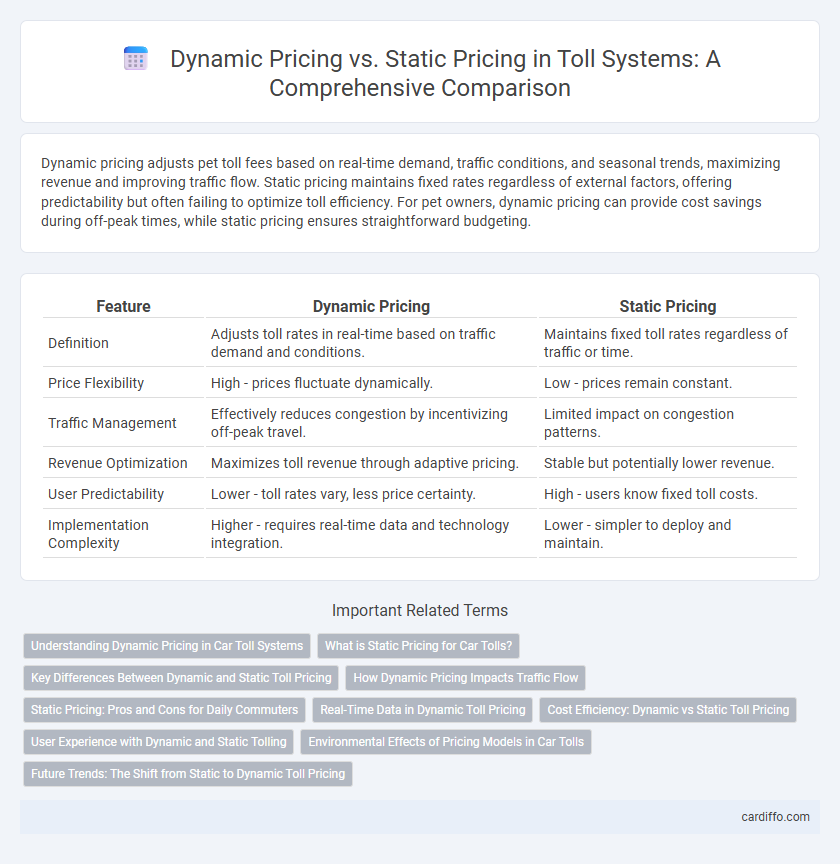Dynamic pricing adjusts pet toll fees based on real-time demand, traffic conditions, and seasonal trends, maximizing revenue and improving traffic flow. Static pricing maintains fixed rates regardless of external factors, offering predictability but often failing to optimize toll efficiency. For pet owners, dynamic pricing can provide cost savings during off-peak times, while static pricing ensures straightforward budgeting.
Table of Comparison
| Feature | Dynamic Pricing | Static Pricing |
|---|---|---|
| Definition | Adjusts toll rates in real-time based on traffic demand and conditions. | Maintains fixed toll rates regardless of traffic or time. |
| Price Flexibility | High - prices fluctuate dynamically. | Low - prices remain constant. |
| Traffic Management | Effectively reduces congestion by incentivizing off-peak travel. | Limited impact on congestion patterns. |
| Revenue Optimization | Maximizes toll revenue through adaptive pricing. | Stable but potentially lower revenue. |
| User Predictability | Lower - toll rates vary, less price certainty. | High - users know fixed toll costs. |
| Implementation Complexity | Higher - requires real-time data and technology integration. | Lower - simpler to deploy and maintain. |
Understanding Dynamic Pricing in Car Toll Systems
Dynamic pricing in car toll systems adjusts toll rates based on real-time traffic demand, congestion levels, and time of day to optimize road usage and reduce traffic jams. Unlike static pricing, which sets a fixed toll fee regardless of conditions, dynamic pricing leverages data analytics, GPS, and sensor inputs to implement variable charges that encourage off-peak travel. This approach enhances traffic flow efficiency, maximizes revenue, and supports sustainable urban mobility by balancing demand across different time periods.
What is Static Pricing for Car Tolls?
Static pricing for car tolls involves fixed rates applied uniformly regardless of traffic conditions or time of day. This approach ensures predictable toll costs for drivers but may lead to congestion during peak hours due to lack of price incentives to shift travel times. Toll authorities often rely on static pricing for its simplicity and ease of administration in controlled traffic environments.
Key Differences Between Dynamic and Static Toll Pricing
Dynamic toll pricing adjusts toll rates based on real-time traffic demand, congestion levels, and time of day to optimize traffic flow and reduce congestion, whereas static toll pricing maintains fixed rates regardless of traffic conditions. Dynamic pricing often relies on advanced algorithms and sensor data to implement variable charges, offering flexibility and responsiveness compared to the predictability and simplicity of static pricing structures. The key differences lie in the adaptability and efficiency of dynamic pricing versus the consistency and ease of implementation of static toll pricing systems.
How Dynamic Pricing Impacts Traffic Flow
Dynamic pricing adjusts toll rates based on real-time traffic conditions, effectively managing demand and reducing congestion during peak hours. By incentivizing off-peak travel with lower tolls, dynamic pricing smooths traffic flow and minimizes bottlenecks on highways. Studies show that dynamic tolling can decrease average travel times by up to 20% compared to static pricing models.
Static Pricing: Pros and Cons for Daily Commuters
Static pricing for tolls offers predictability and simplicity, allowing daily commuters to budget consistently without surprise fluctuations. However, this pricing model can lead to congestion during peak hours since rates remain fixed regardless of demand, potentially increasing travel time. While static pricing supports straightforward toll collection systems, it may fail to optimize traffic flow or incentivize off-peak travel.
Real-Time Data in Dynamic Toll Pricing
Dynamic toll pricing leverages real-time data such as traffic flow, congestion levels, and time of day to adjust toll rates instantly, optimizing road usage and reducing traffic bottlenecks. Unlike static pricing, which sets fixed toll rates regardless of demand fluctuations, dynamic pricing enables responsive cost adjustments that reflect current travel conditions. Integrating IoT sensors and GPS data enhances the accuracy of dynamic toll pricing, promoting efficient traffic management and improved commuter experiences.
Cost Efficiency: Dynamic vs Static Toll Pricing
Dynamic toll pricing adjusts fees in real-time based on traffic demand, improving cost efficiency by optimizing revenue during peak hours and reducing congestion-related expenses. Static toll pricing maintains fixed rates regardless of traffic conditions, often leading to underutilized infrastructure during off-peak times and excessive delays during rush hours. By implementing dynamic toll pricing, authorities can balance traffic flow and maximize revenue, resulting in enhanced economic and operational efficiency over static toll systems.
User Experience with Dynamic and Static Tolling
Dynamic pricing in tolling adjusts rates based on real-time traffic conditions, enhancing user experience by minimizing congestion and reducing travel time. Static pricing offers predictable toll costs, providing consistency but often leading to increased delays during peak hours due to fixed rates. User satisfaction tends to improve with dynamic tolling as it promotes smoother traffic flow and more efficient road usage.
Environmental Effects of Pricing Models in Car Tolls
Dynamic pricing in car tolls adjusts rates based on traffic congestion and environmental conditions, effectively reducing emissions by discouraging peak-time travel and promoting smoother traffic flow. Static pricing maintains consistent toll rates regardless of demand, often leading to higher congestion and increased vehicle emissions during peak hours. Implementing dynamic pricing models demonstrates significant potential in lowering air pollution and carbon footprints in urban areas by optimizing traffic patterns and reducing idle times.
Future Trends: The Shift from Static to Dynamic Toll Pricing
Dynamic toll pricing leverages real-time traffic data and advanced algorithms to adjust toll rates, optimizing roadway efficiency and reducing congestion during peak hours. Future trends indicate a significant shift from static toll pricing, which relies on fixed rates regardless of traffic conditions, toward adaptive models that respond to fluctuating demand and enhance revenue management. Implementing dynamic pricing systems supports smart city initiatives by enabling more sustainable transportation networks and improved commuter experiences.
Dynamic Pricing vs Static Pricing Infographic

 cardiffo.com
cardiffo.com